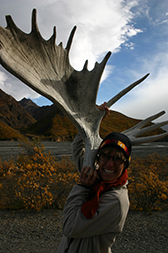As arctic temperatures rise, we expect to see dramatic changes due to thawing permafrost soils. Permafrost stores half the total amount of carbon (C) found in soils globally, and twice as much C as is found in the atmosphere. As permafrost thaws, the stored C becomes vulnerable to loss because low temperatures no longer limit microbial activity. However, thawing soils and warmer temperatures may also allow plants to access more nutrients and grow deeper roots. In the short-term greater plant growth can therefore offset C losses from the soil. Uncertainty about how plants and microbes interact, as the ecosystem continues to change, makes it extremely difficult to predict how warming will affect permafrost C dynamics in both the short, and the long term. Using data from a 5 year field warming experiment in the Tundra, lab soil incubations and 13C&14C signatures from soil respiration, I am interested in improving our understanding of how rising arctic temperatures will affect the C balance of arctic ecosystems.
back to people














